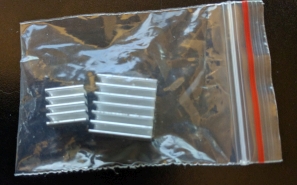The Pi 3 generates way more heat than its predecessors. There are tons of dirt cheap heatsinks available for less than $1 from AliExpress and sometimes they come for free with cases.
I wanted to see if these were worth using or if I should splurge on some better ones.
My Lazy, Non-Scientific Test Environment
- Clean install of Raspbian Jessie
- Raspberry Pi 3 Model B v1.2, made in the U.K.
- Removed the sticky pads on the heatsinks and used Artic Silver
- Ambient Temperature: 24C
- Test program:
sysbench --num-threads=4 --test=cpu --cpu-max-prime=20000 run
All heatsinks cost $1 or less (~35 cents in the case of the aluminum ones) and are small.
Aluminum vs Copper vs Ceramic Heat Sinks
Test #1 – No Heatsink
Pi reached it’s throttling temperature of 85C fairly quickly. It took 135 seconds to complete the benchmark.
Test #2 – Ceramic Heatsink
Max temp of 78C. Did not throttle. 119 seconds.
Test #3 – Aluminum Heatsink
This was the really cheap one that came free with a case. It worked, but barely. I’d still say it’s better than nothing.
Max temp 85C – reached near the end of the test. 126 seconds.
Test #4 – Copper Heatsink
Max temp 79C. No throttling. 119 seconds.
Conclusion: Heatsinks are Worth It for the Pi 3
But spend a couple dollars more and get a better (larger) one. These ones were all too small to dissipate much heat.
In most normal usage you probably won’t hit 85C much, but I sometimes hit 77 to 80C when rendering certain live HDTV streams on my Pi 3 OSMC (Kodi) box working as a TvHeadend client. It makes a little thermometer icon show up in the top right corner.
